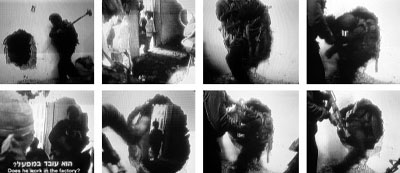Violent Architectures
Another event not to be missed, Violent Architectures: New Wars and Arab Cities. This coming Wednesday, June 28th, Eyal Weizman joins Derek Gregory at the ICA in London to explore Arab cities in the context of armed conflict, how the urban environment is being shaped by the military forces that operate within it. From the website, "The urban environment, they suggest, must be understood not simply as the backdrop to conflict, but as trapped in a complex feedback-based relation with the forces operating within it – be they a diverse local population, soldiers, guerrilla, media or humanitarian agents."
Weizman, was recently awarded the 2006–07 James Stirling Memorial Lectures on the City Competition for his proposal: Destruction by Design: Military Strategy as Urban Planning. I recently managed to catch him with with Teddy Cruz and Andrew Ross at The Political Equator event down along the border, and audio recorded the talks (though, trying to improve the quality, more on that later).

Anyway, check out Weizman's recent paper 'Lethal Theory': "The fact that most contemporary military operations are staged in cities suggests an urgent need to reflect on an emergent relationship between armed conflicts and the built environment. Contemporary urban warfare plays itself out within a constructed, real or imaginary architecture, and through the destruction, construction, reorganization, and subversion of space. As such, the urban environment is increasingly understood by military thinkers not simply as the backdrop for conflict, nor as its mere consequence, but as a dynamic field locked in a feedback-based relationship with the diverse forces operating within it – local populations, soldiers, guerrilla fighters, journalists and photographers, and humanitarian agents. This essay belongs to a larger investigation of the ways in which contemporary military theorists are conceptua l i z i n g the urban domain. What are the terms they are using to think about cities? What does the language employed by the military to describe the city to themselves (for example, at international conferences dealing with urban warfare) and to the general public (most often through the media) tell us about the relationship between organized violence and the production of space? What does this language tell us about the military as an institution? Not least important is the question of the role of theory in all these operations."

Gregory is a professor in the Department of Geography at the University of British Columbia, and wrote this book: The Colonial Present: Afghanistan, Palestine, Iraq, in which he traces the history of British and American involvements in the Middle East up to a defining look at the 'War on Terror' as "a series of political and cultural responses that mapped a profoundly colonial perimeter of power." He was recently awarded the Founder‘s Medal of the Royal Geographical Society back in May for his research. Two other articles you should check out concerning the production of an 'imaginative geography' through Occupation and the U.S. military's brand of terrorist incarceration: Who's Responsible? Dangerous Geography, and Tortured Geography.
The talk should be great, and so, as usual, if you happen to make it, report back and give us some scoop.
(This event came to my attention via the always del.icio.us > Images via Eyal Weizman: 'Lethal Theory')







1 Comments:
Regarding the militarization of space:
Why did Cornell University have a CIA operative as the Dean of its college of architecture during the cold war?
Post a Comment
<< Home